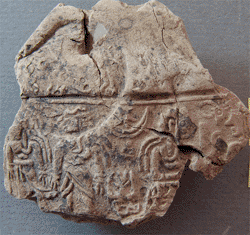

The impression of a cylinder seal on an unbaked clay jar sealing from Konar Sandal
(Courtesy Youssef Madjidzadeh)
They are tiny and often faded and fragmented. But one abundant source of evidence for both international trade and the role of women in eastern Iran during the third millennium B.C. are the tiny images found on seals and sealings throughout this area. The small impressions were designed to mark ownership and control of goods, from bags of barley to a storeroom filled with oil jugs.
Holly Pittman, an art historian at the University of Pennsylvania who has worked throughout the Middle East and Central Asia, is examining the fragile impressions. She is attempting to build a clearer picture of the lives of ancient inhabitants in large centers such as Shahr-i-Sokhta, Shahdad, and Konar Sandal, near today's modern city of Jiroft. Pittman now believes these people of eastern Iran shared common ideas and beliefs while also participating in the first age of long-distance exchange.
Female deities with vegetation growing out of their bodies are one common element on the seals found in eastern Iran and, as on the Shahdad flag, figures confronting one another also appear Lasting Impression frequently. A distinctive type of white stone seals that have been found in Central Asia and the Indus appear to have been made in a similar style by eastern Iranians. "There are relationships between sites, and certainly this part of eastern Iran is participating in a global network," she says. "This is a world of merchants and traders."
Pittman believes that by early in the third millennium B.C., the network linking Mesopotamia and southeastern Iran resulted in a mixing of cultures across this enormous area. Seals that were used to close storage rooms in Konar Sandal, for example, are of a specific Mesopotamian type common in the major Iraqi port of Ur. That hints strongly at the presence of Mesopotamian inhabitants in Konar Sandal who had almost certainly come from Ur. She also suggests that Mesopotamian artifacts absorbed style elements from southeastern Iran. Another example is the famous inlaid lyre found at Ur, which has the face of a bearded bull typical of eastern Iran. Other seals found in ruins such as Konar Sandal are Proto-Elamite in style, showing strong connections with western and central Iran, where the Proto-Elamite writing system is believed to have originated at the same time that Mesopotamian urban life began to flourish in the late fourth millennium B.C.
Seals were powerful markers of economic, political, and social clout. At some eastern Iranian sites such as Shahr-i-Sokhta, they appear to have been largely in the hands of women. Marta Ameri, an archaeologist at the Fashion Institute of Technology in New York, notes that two-thirds of the seals found in Shahr-i-Sokhta's graves are found in female burials. While the grander bronze seals are uncovered mostly in male tombs, the more common bone seals are more often associated with women. Based on remains of sealings made to doors, vases, bags, and other objects, the bone seals were in more frequent use than the bronze. This suggests, Ameri says, that women were in control of food storage and possibly trade goods as well. Until more intact graves are found at other sites such as Shahdad, "we at least have a tantalizing look at the roles women may have played," says Ameri.
Andrew Lawler is a contributing editor at ARCHAEOLOGY. For our 1975 coverage of the excavations at Shahr-i-Sokhta, see archive.archaeology.org/iran.
Advertisement

Advertisement









